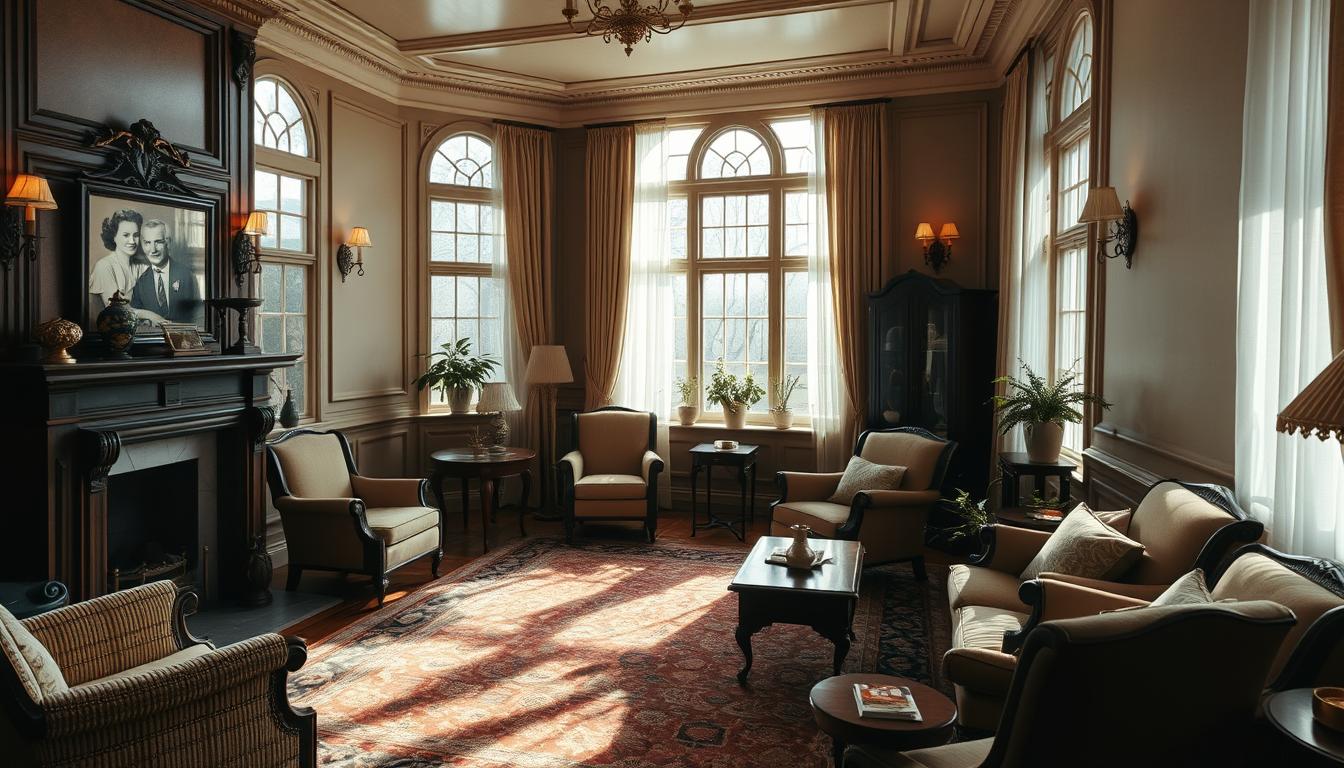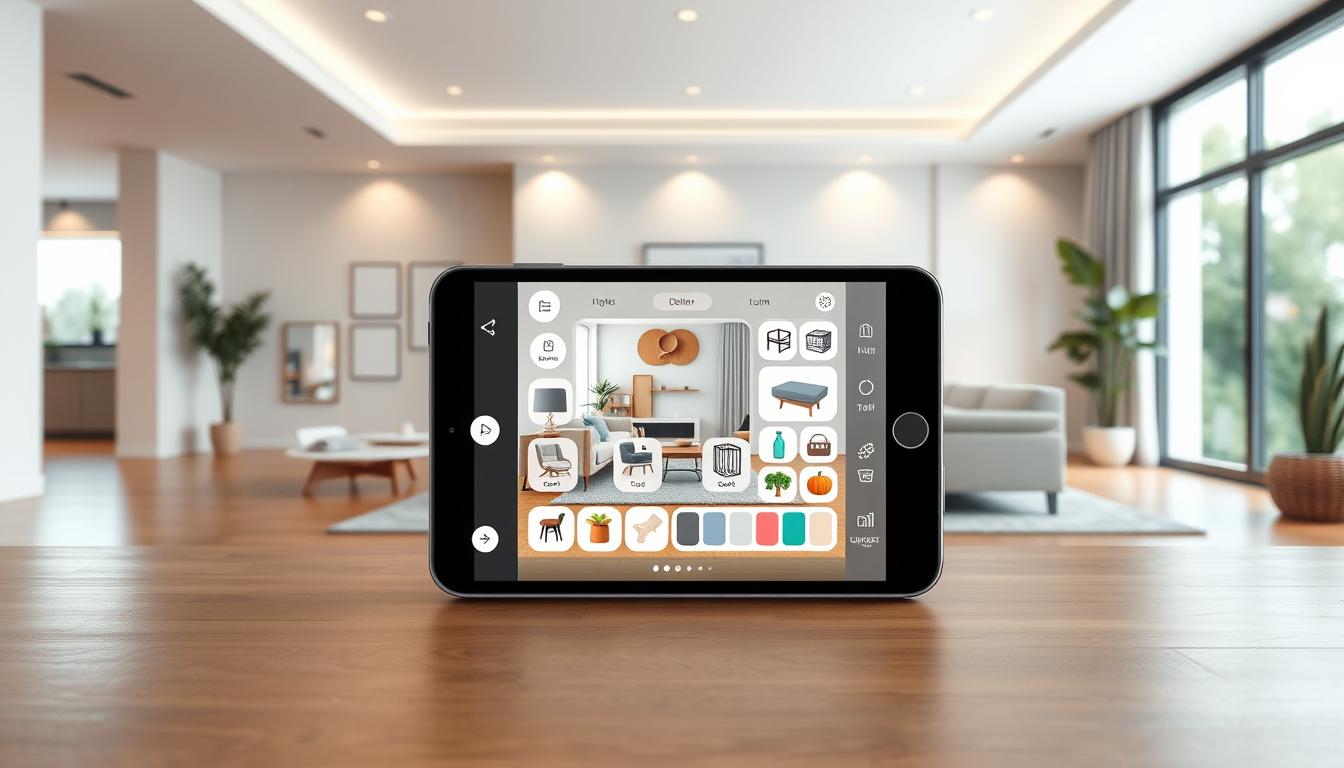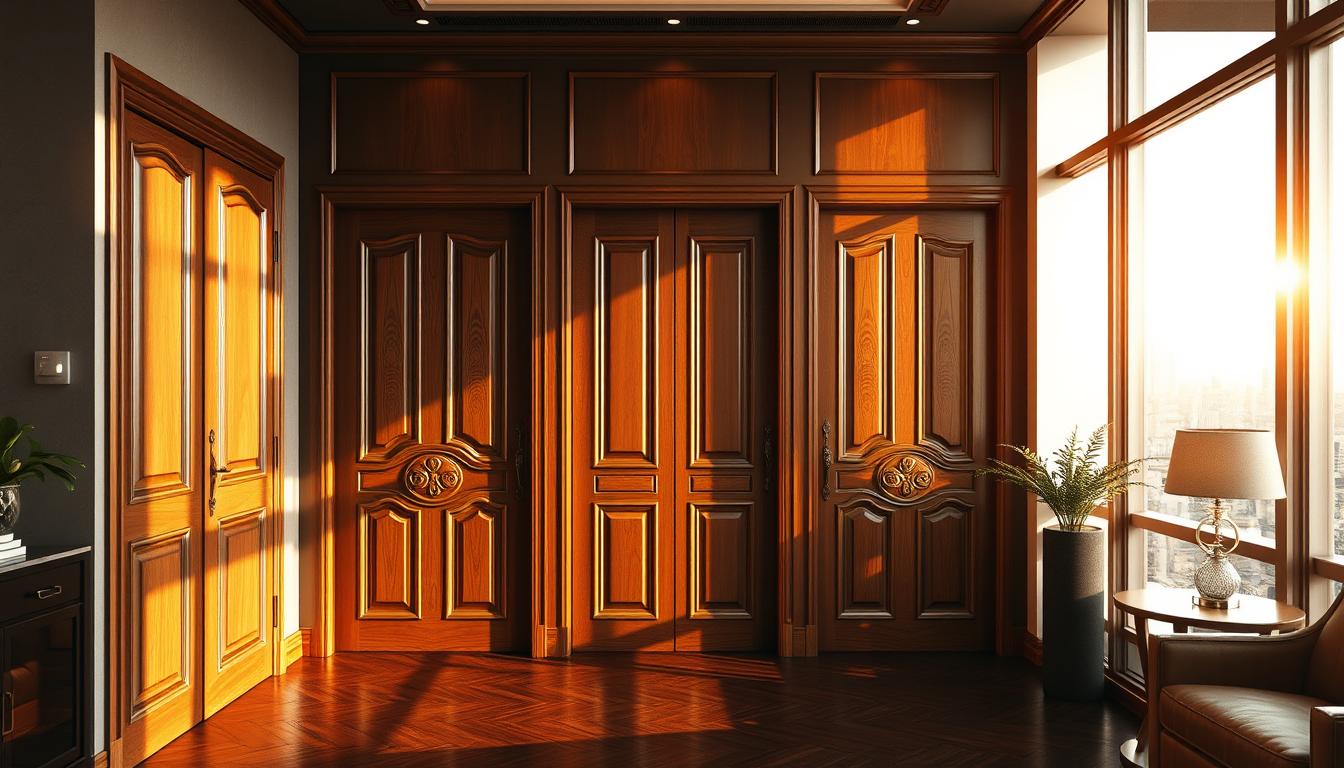The charm of 1930s homes is still loved by many. They mix elegance with vintage flair in a special way. These homes were known for their detailed designs, rich colors, and classic furniture.
Exploring 1930s interior style reveals its key design elements. We’ll share tips on adding these to your home decor. You’ll learn about statement pieces and subtle accents to bring timeless elegance to your space.
Key Takeaways
- Understand the characteristic design elements of 1930s homes.
- Learn how to select the right furnishings and decor.
- Discover practical tips for recreating vintage elegance.
- Explore ways to incorporate classic sophistication into your home.
- Find inspiration for creating a unique and timeless interior style.
Understanding the 1930 Homes Aesthetic
The 1930s homes have a unique look that blends modern and traditional styles. They show the influence of Art Deco, making them stand out in design history. This era’s homes are known for their rich materials, geometric patterns, and focus on leisure and entertainment.
Key Characteristics of 1930s Design
The 1930s design era has distinct features that define its look. Some key aspects include:
- The use of rich materials like oak, walnut, and exotic veneers in furniture making.
- Geometric patterns and motifs, often inspired by Art Deco, were common in textiles, wallpaper, and flooring.
- A focus on craftsmanship, with an emphasis on high-quality construction and attention to detail.
These elements combined to create a unique look that was both modern and traditional. Design historians note, “The 1930s saw a resurgence in traditional craftsmanship, coupled with a keen interest in modern design principles.”
“The 1930s was a decade that celebrated the beauty of modernity while honoring the past through its use of traditional craftsmanship.”
Influences on 1930s Interior Decor
The interior decor of 1930s homes was shaped by various factors, including social and cultural changes. The growing interest in leisure and entertainment led to the creation of spaces for relaxation and socializing.
Some key influences on 1930s interior decor include:
- The rise of Art Deco, which brought a glamorous, modern aesthetic to interior design.
- The influence of international travel, which introduced new ideas and motifs into home decor.
- A growing interest in historic preservation and the restoration of vintage homes, which helped to fuel a renewed appreciation for traditional design elements.
By understanding these influences, we can appreciate the unique aesthetic of 1930s homes. We see how they reflect the era’s values and cultural shifts.
Popular Color Palettes in 1930 Homes
The charm of 1930s homes comes from their warm interiors. This is thanks to their unique color palettes. These homes used earthy tones and pastel hues, making them stand out.
Earthy Tones and Pastel Hues
Earthy tones like ochre, sienna, and umber were common in 1930s design. These warm colors were paired with softer pastels. This mix created a soothing and beautiful look.
To get this look, mix earthy tones with pastel hues. For example, a sienna wall looks great with pastel blue accents. This mix brings a retro style that’s both stylish and true to the era.
Mixing and Matching Colors
Learning to mix colors is key to capturing 1930s style. The trick is to balance warm earthy tones with soft pastels. Here’s a simple guide to help you:
| Color Category | Example Colors | Usage Tips |
|---|---|---|
| Earthy Tones | Ochre, Sienna, Umber | Use as primary wall colors or for furniture. |
| Pastel Hues | Pastel Blue, Soft Pink, Mint Green | Use as accent colors for decor and accessories. |
| Neutral Shades | Beige, Cream, Light Gray | Use to balance earthy tones and pastel hues. |
Mixing these colors can create a retro look that’s both old and new. The secret is to find a balance. This makes your space inviting and harmonious.
As we explore 1930s homes, we see how colors shaped their style. Next, we’ll look at the furnishings that made this style iconic.
Furnishings That Define the 1930s
The 1930s was a time of big change in interior design. It brought us unique furnishings that still shape classic home styling today. This era mixed modern simplicity with traditional details, creating a look that’s still loved in traditional interior design.
Iconic Furniture Styles of the Era
The 1930s had many furniture styles, from Art Deco’s glamour to modernism’s clean lines. Art Deco added luxury with its geometric shapes and rich materials. Modernist furniture, on the other hand, focused on function and simplicity, using new materials like tubular steel.
Some standout furniture pieces from the 1930s include:
- Curved sofas and chairs with plush upholstery
- Tubular steel furniture with minimalist designs
- Ornate wooden dressers and sideboards with intricate carvings
- Console tables with mirrored surfaces and decorative metalwork
Reproductions vs. Vintage Finds
Choosing between reproductions and vintage pieces is a big decision for 1930s-style homes. Vintage finds bring real authenticity and charm but can be pricey and need fixing. Reproductions, on the other hand, are cheaper and more practical, offering a 1930s look without the high cost.
“The charm of vintage furniture lies not only in its aesthetic appeal but also in its history and craftsmanship.” – Interior Design Expert
Whether to choose vintage or reproduction furniture depends on what you like, your budget, and how true to the era you want to be. Many designers suggest mixing both for a unique, layered look that celebrates 1930s design.
Wall Treatments and Textures
Wall treatments in 1930s homes mixed function with beauty. They showed off the era’s design tastes. Different textures and materials made spaces more interesting.
The 1930s brought back old craftsmanship. Walls often had wood paneling, plaster, and wallpaper together. These added texture and warmth to homes.
Wallpaper Trends of the 1930s
Wallpaper was big in 1930s homes. Designs ranged from simple to bold, geometric patterns. Metallic accents and Art Deco-inspired designs added glamour.
Some top 1930s wallpaper trends include:
- Geometric patterns, like chevrons and hexagons
- Floral motifs, with stylized flowers
- Metallic accents for luxury
The Renaissance of Plaster and Wood
1930s homes also had plaster and wood walls. These materials were strong and looked good. They were used for paneling and moldings.
| Material | Characteristics | Use in 1930s Homes |
|---|---|---|
| Plaster | Durable, versatile, can be finished to a high sheen | Used for walls, ceilings, and decorative features |
| Wood Paneling | Warm, inviting, can be stained or painted | Used to add texture and visual interest to walls |
| Wallpaper | Variety of designs, can be used to add color and pattern | Used to create a focal point or add visual interest |
Using these wall treatments and textures can make a 1930s interior look authentic and stylish.
Flooring Options for 1930 Homes
1930 homes were known for their flooring, featuring classic hardwood and decorative tiles. This flooring added both durability and beauty to the homes’ interiors.
For those wanting to bring back the vintage charm of 1930 homes, knowing the flooring options is key. We can mix old charm with new touches to meet today’s tastes.
Classic Hardwood Choices
Hardwood flooring was a favorite in 1930 homes for its lasting quality and timeless look. Oak, maple, and cherry were top picks, often laid in wide planks to make rooms feel bigger.
“Hardwood flooring adds warmth and character to a room,” a truth that held true in the 1930s. This appeal remains strong today, making hardwood a popular choice.
The Allure of Art Deco Tiles
Art Deco tiles also became popular in the 1930s. These tiles, with their geometric patterns and metallic touches, brought glamour to kitchens, bathrooms, and entryways.
For those keen on vintage decor, adding Art Deco tiles is a smart move. It honors the era’s style while adding a modern twist to any space.
By mixing classic hardwood with Art Deco tiles, homeowners can create a flooring that’s both true to the 1930s and perfect for today’s homes.
Lighting Fixtures That Make a Statement
Statement lighting was key in 1930s design, showing off luxury and elegance. In historic house design, lighting was more than just light. It made spaces look better.
To get the lighting right in 1930s homes, knowing the common styles is crucial. For inspiration, check out luxe interior design ideas.
Common Lighting Styles in 1930s Interiors
The 1930s had many lighting styles, from modern to ornate. Some top styles include:
- Art Deco Fixtures: Known for geometric shapes, metallics, and bold designs, Art Deco lighting was big in the 1930s.
- Chandeliers: Grand and ornate, chandeliers were a big deal in dining rooms and entryways.
- Sconces: Wall-mounted sconces added ambient light and decorated rooms.
These styles showed off 1930s architecture and shaped home aesthetics.
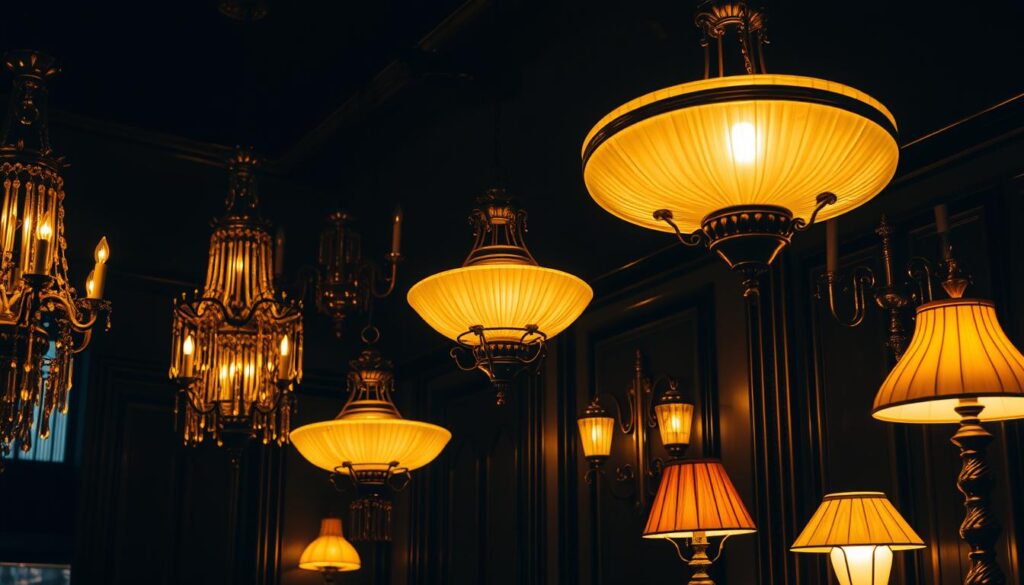
Reviving Vintage Lighting Options
Adding vintage lighting to modern homes is possible. You can restore original fixtures or find new ones to keep a historic home’s feel.
Here’s a table comparing vintage lighting options:
| Lighting Style | Characteristics | Restoration Tips |
|---|---|---|
| Art Deco | Geometric patterns, metallic finishes | Clean gently, restore metallic finishes |
| Chandeliers | Ornate designs, crystal or glass drops | Dust regularly, replace damaged crystals |
| Sconces | Wall-mounted, ambient lighting | Check electrical components, repaint or refinish |
Interior design experts say, “Reviving vintage lighting is more than keeping history alive. It’s about adding history to your home.” Choosing vintage lighting adds a unique touch to your space.
“The right lighting can transform a room, making it feel more welcoming and sophisticated. In the context of 1930s homes, it’s about capturing the essence of an era known for its opulence and style.”
Embracing 1930s Patterns in Decor
Patterns were key in retro interior design, and the 1930s were no different. Geometric and floral designs were big hits. They brought depth and character to rooms, making them stand out.
In traditional interior design, patterns do more than look good. They also bring history and continuity to a space. To add 1930s patterns to your home, first learn about the designs of that time.
Understanding Geometric and Floral Designs
Geometric patterns like chevrons and hexagons were big in the 1930s. They showed up in flooring, wallpaper, and furniture. Floral patterns, with their stylized plants, were more subtle. Knowing the difference between these patterns is crucial for using them right in your decor.
Floral designs weren’t just for wallpaper; they also appeared in textiles like curtains and upholstery. To use floral patterns well, pair them with solid colors. A floral pattern can add elegance to any room.
Incorporating Patterns Without Overdoing It
To add 1930s patterns to your home without too much, start with small things like throw pillows, rugs, or curtains. This way, you can introduce the era’s style without taking over the space. It’s about finding the right balance and mixing patterns with solid colors.
For example, pair a geometric patterned rug with solid-colored furniture. Then, add floral throw pillows for another 1930s touch. The goal is to blend these elements in a way that honors the era without feeling too retro or too much.
- Start with accessories to introduce patterns.
- Balance patterns with solid colors.
- Mix geometric and floral designs thoughtfully.
By embracing 1930s patterns, you can give your home a unique and stylish look. Whether you’re going for a full retro look or just a few nods to the era, knowing and using these patterns can make a big difference.
Designing Functional Spaces in 1930 Homes
Bringing 1930s style into our homes means finding a balance. We need to keep the old charm while making it work for today. This balance is key when we restore and decorate these homes.
Balancing Aesthetics with Practicality
We start by choosing period home furnishings that look good and feel great. For example, we can update old sofas with new, easy-to-clean fabrics. This keeps the look of the 1930s but adds modern comfort.
Adding modern touches carefully can make a room more useful without losing its old-time feel. We can add new lights or storage that fits right in with the vintage home decor.
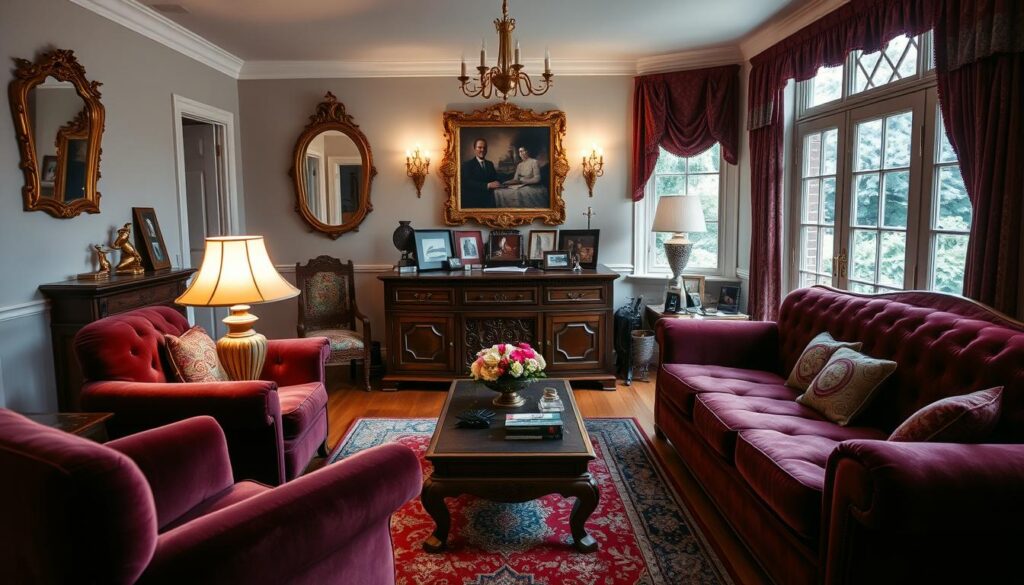
Creating Cozy Living Areas
To make living areas cozy in 1930 homes, we mix different textures and colors. Rich wood, soft carpets, and comfy seats make a space feel like home.
Lighting is also key to coziness. Vintage-style lamps add warmth and character. They also light up the room for reading and other activities.
By mixing old and new, we create spaces that are both lovely and practical. These spaces truly capture the spirit of the 1930s.
Decorating Tips for Modern 1930s Interiors
Decorating a 1930s home is all about finding the right mix. You need to keep its old charm while making it cozy for today’s life. It’s a delicate balance.
Blending Vintage with Contemporary Elements
Begin by picking out the old features you want to keep. Look for intricate moldings, hardwood floors, and vintage lighting fixtures. These are the heart of your home’s look.
Then, think about adding modern touches that fit with these old pieces. For example, pair a classic armchair with a modern sofa. Or, add a new area rug to your hardwood floors.
- Mix vintage and modern furniture for a unique vibe.
- Use modern lights to show off the old architecture.
- Add new throw pillows and blankets for color and texture.
Keeping It Authentic While Staying Current
To keep a 1930s home feeling both old and new, start by knowing its style and era. Then, figure out how to update it for today’s tastes.
Here are some tips to stay true to your home’s past while making it modern:
- Fix up original parts like windows and doors to their former glory.
- Use old colors and patterns in a fresh way.
- Add modern tech like smart devices without losing the home’s old charm.
By mixing the old with the new, you can make a space that respects its history and meets today’s needs.
Frequently Asked Questions About 1930 Homes
Exploring 1930 homes brings up many questions about their design and upkeep. Let’s tackle some of these to help you appreciate the classic style of this era.
Common Misconceptions About 1930s Interior Design
Many think 1930s design is all about bold, retro patterns. But, traditional design was also key. The goal is to mix vintage charm with timeless beauty.
Maintaining the Integrity of 1930 Homes
Keeping 1930 homes true to their roots means preserving original features. Adding period furnishings that match their unique style is crucial. This way, you blend old and new beautifully, respecting the home’s history.
Understanding 1930s design and restoring with care lets you enjoy a home that’s both preserved and stylish. It’s a way to celebrate classic home styling.

